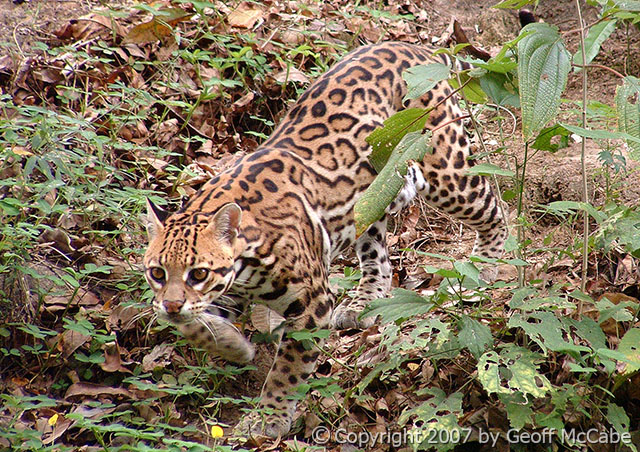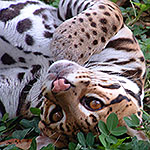
- Home
- Accommodation
- Activities
- Area Info
- Maps
- Photo Galleries
- Real Estate
- Travel
Spanish Name: Manigordo
Height Weight: This cat has a head and body length of 0.7 to 0.9 m, and a tail of 0.28 to 0.4 m. Females are slightly smaller than males. Adults weigh about 13 kg.
Found In: Dry deciduous forest, primary or secondary rainforests, and valleys.
Average Lifespan: About 10-13 years in the wild and two decades in captivity.
 Known as a “Manigordo” in Spanish, which literally translates into fat hand, the ocelot the ocelot is relatively big for a cat, smaller only than the puma and jaguar. The ocelot is an extremely secretive cat, and is therefore not usual spotted. This can also be attributed to its dwindling numbers owing to them being hunted in large numbers for the fur trade. Though it has now become unlawful to export fur to the United States, this feline now faces another challenge that is true for most cats in Costa Rica- habitat destruction. Ocelots can thrive in dense vegetation cover and as such are opportunistic eaters. Without their cover, these stealthy mammals are unable to hunt or survive.
Known as a “Manigordo” in Spanish, which literally translates into fat hand, the ocelot the ocelot is relatively big for a cat, smaller only than the puma and jaguar. The ocelot is an extremely secretive cat, and is therefore not usual spotted. This can also be attributed to its dwindling numbers owing to them being hunted in large numbers for the fur trade. Though it has now become unlawful to export fur to the United States, this feline now faces another challenge that is true for most cats in Costa Rica- habitat destruction. Ocelots can thrive in dense vegetation cover and as such are opportunistic eaters. Without their cover, these stealthy mammals are unable to hunt or survive.
The feet of this feline make is an adept tree climber and they are often found sleeping inside trees and other dense vegetation. The primary color of its coat varies from grayish to cinnamon, with black spots that form rings on the neck or long spots on the body. Its tail has some band like markings. Much like the human fingerprint, no two ocelots ever have the same coat pattern.
The ocelot is a solitary animal and moves and hunts alone. The territory of an adult male may have a total area of up to 17 kilometers, overlapping female territories which may be about 15 km. The female mostly gives birth to 1-2 kittens at a time, though sometimes 3-4 are born at once after a gestation period of about 70 to 80 days. The kittens are raised in thick vegetation and an extremely isolated place. Ocelots are nocturnal cats, and sleep in tree hollows during the day. They can be spotted in the densely forested areas of Montezuma on a night wildlife viewing safari, though it is difficult to see them owing to their highly guarded and stealthy nature. Though not as extensively spotted as other felines, visitors may be lucky enough to catch a quick sight of this mammal in thick vegetation.
 The Ocelot generally hunts on the ground, but it is an adept climber and swimmer well and will often climb trees dexterously whenever needed. Their hunting style us not as much about observing and following their potential prey like other cats, but more about instantly pouncing on prey. Studies have shown that Ocelots track their prey with the help of odor trails, and these mammals are known to possess superb night vision. The sly ocelot is capable of killing and feeding on animals larger than itself such as collared but that’s more an exception than the rule. Their regular diet comprises rodents, armadillos, agoutis, opossums, porcupines, anteaters, kinkajous, lizards, snakes, bats, iguanas, frogs, fruit, turtles, and crabs. Ocelots are also known to fastidiously remove the feathers off a bird’s body before eating it. The ocelot, like some others felines will carefully hide a partly eaten prey and return for it later. They like to save up their food for a rainy day and intriguingly will remember Exactly where they left behind their food.
The Ocelot generally hunts on the ground, but it is an adept climber and swimmer well and will often climb trees dexterously whenever needed. Their hunting style us not as much about observing and following their potential prey like other cats, but more about instantly pouncing on prey. Studies have shown that Ocelots track their prey with the help of odor trails, and these mammals are known to possess superb night vision. The sly ocelot is capable of killing and feeding on animals larger than itself such as collared but that’s more an exception than the rule. Their regular diet comprises rodents, armadillos, agoutis, opossums, porcupines, anteaters, kinkajous, lizards, snakes, bats, iguanas, frogs, fruit, turtles, and crabs. Ocelots are also known to fastidiously remove the feathers off a bird’s body before eating it. The ocelot, like some others felines will carefully hide a partly eaten prey and return for it later. They like to save up their food for a rainy day and intriguingly will remember Exactly where they left behind their food.
The Ocelot is extremely territorial by nature. In clashes over territory, the Ocelot will fight to its death. Fiercely independent by nature, this cat is solitary, interacting with other individuals only to mate. Ocelots are often found resting between trees, thick vegetation, and caves. Ocelots are sometimes known to share their area with another member of the same sex.
Ocelots can inhabit relatively disturbed areas, but deforestation and habitat loss has made them vulnerable to hunting. In the 70’s and 80’s, thousand of these magnificent creatures were killed for their pelts. Though the pelt demand has now plummeted, there are still some hunters in Costa Rica. Unfortunately for their population in the wild, their reproduction takes place at a very slow place, and even in preserved forest areas, they are unable to make up for the loss of their dwindling numbers.
Ocelots will spend approximately 10 hours moving and cover about 4 miles a night. Male Ocelots are known to have territorial ranges that are bigger than the female’s. Though males tend to overlap into the female territory they will never share another male’s range. An ocelot marks its territory by urinating on vegetation, scratching logs, and scratching off a small patch of ground with the help of their hind feet.
http://travelcostaricanow.com/index.php/Ocelot
http://www.iucnredlist.org/details/11509/0
http://www.wildernessclassroom.com/wilderness-library/ocelot/
My new favorite restaurant, Clandestina is not to be missed by food lovers staying anywhere near to Montezuma. Established in March 2015, Clandestina is the new kid on the block. The Oregon/Tico collaboration is a winner among locals and travelers alike, with artisan craft beers, made onsite by Butterfly Brewing Co. and delicious, exciting […]